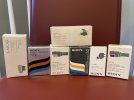Well, you need to know what you are looking for in order to see the wear. Most folks don't realize how small the contact patches actually are, and miss them even when looking directly at them! Lighting is also super critical, as diamond is a difficult subject to view and photograph.
That 2M Blue has ~500 hours of play time, and is pretty well-worn. A new 2M Blue has a "minor" radius of 0.3mil/8um, implying it will form a flat contact patch length of ~0.4mil/11um after ~100 hours or so of play. The 2M image above shows a contact patch length of 0.5mil/13um.
You are correct that "wear" can be mimicked by poor lighting. I've been fooled by this, and had to develop lighting systems and analysis techniques that would discriminate true versus phantom wear. I show a diagram above that is one aspect of this, and the composite view shown in first post is another aspect. True wear is most difficult to distinguish early in the stylus life, but later (like the 2M Blue) it is much easier.
Record wear is still a mystery to me. I brought it up since it often comes up in forum discussions, with folks worrying that their worn stylus is causing record damage. I've seen SEM photos of grooves with damage from playing, but I've never seen a scientific study to show wear vs hours of play or condition of stylus, let alone effect of stylus type. I can't agree with your statement about hyperellipticals causing more damage, as I don't know of any data to show the effect of one stylus type vs another.
 This was fom a JVC 4MD-20X cartridge:
This was fom a JVC 4MD-20X cartridge:

